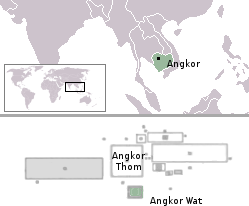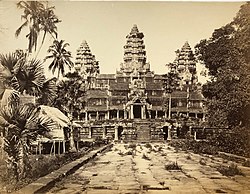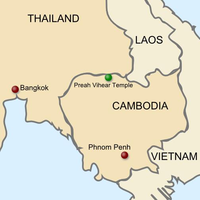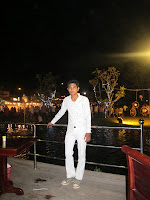


Angkor Wat (or Angkor Vat) (Khmer: អង្គរវត្ត) is a temple complex at Angkor, Cambodia, built for the king Suryavarman II in the early 12th century as his state temple and capital city. As the best-preserved temple at the site, it is the only one to have remained a significant religious centre since its foundation—first Hindu, dedicated to the god Vishnu, then Buddhist. The temple is the epitome of the high classical style of Khmerarchitecture. It has become a symbol of Cambodia, appearing on its national flag, and it is the country's prime attraction for visitors.Angkor Wat combines two basic plans of Khmer temple architecture: the temple mountain and the later galleried temple, based on early South Indian Hindu architecture, with key features such as the Jagati. It is designed to represent Mount Meru, home of the devas in Hindu mythology: within a moat and an outer wall 3.6 kilometres (2.2 mi) long are three rectangular galleries, each raised above the next. At the centre of the temple stands a quincunxarchitecture, its extensive bas-reliefs and for the numerous devatasThe modern name, Angkor Wat, means "City Temple"; Angkor is a vernacular form of the word nokor which comes from the Sanskrit word nagara meaning capital. wat is the Khmer word for temple. Prior to this time the temple was known as Preah Pisnulok, after the posthumous title of its founder, Suryavarman II.[1] of towers. Unlike most Angkorian temples, Angkor Wat is oriented to the west; scholars are divided as to the significance of this. The temple is admired for the grandeur and harmony of the (guardian spirits) adorning its walls.
Angkor Wat HistoryThe whole Angkor period spans for more than VI centuries, and more precisely from IX till XV century. During this period the Khmer empire reached its maximum splendor as one of the most powerful southeast asian kingdoms. In this period the whole area of Angkor was buit. We can consider Jayavarman II as the man that started everything. He define himself Devaraja (good king) and he established the Khmer empire in 802.
 After him, Indravarman, a king considered by many of its time an usurper: we prefer to remember him for starting building the Baray, a complex irrigation system to bring waters in the area of Angkor. He also started to build the Bakong and the Preah Ko temples. His son Yasovarman went further in his father's project: he built the Phnom Bakheng and the Lolei temples, and with him, Angkor become the new capital of the kingdom. These two king further extent the Baray's system too.
After him, Indravarman, a king considered by many of its time an usurper: we prefer to remember him for starting building the Baray, a complex irrigation system to bring waters in the area of Angkor. He also started to build the Bakong and the Preah Ko temples. His son Yasovarman went further in his father's project: he built the Phnom Bakheng and the Lolei temples, and with him, Angkor become the new capital of the kingdom. These two king further extent the Baray's system too.
Then the capital was moved to Koh Ker for a short period, under the kingdom of Jayavarman IV, an usurper, but after only 14 years Angkor become again the capital under Rajendravarman II. His son, Jayavarman V, was instead a great king, and with him the empire expanded to its maximum extent. Two wonderful temples, as Banteay Srei and Ta Keo were built.
After him, Udayaditavarman II built the pyramid of Baphuon and the western Mebon (we are now at the half of XI century), and here we are really close to the very peak of the Khmer civilization, two great king the left once forever their footstep in the history of this planet and they are Suryavarman II and Jayavarman II. The first king built Bang Melea but it also the one that built Angkor Wat. The second king has built Preach Khan, Ta Phrom and Angkor Thom.
As you will see with your eyes these last temple are traces of a high level civilization, with an exquisite taste for art. An enormous job that involved not only an army of thousands workers doing the hard job, building, moving rock and materials and so on. There was another parallel army of thousands of artists and artisans. Angkor Wat is also them. We will never know their names, or their faces, but what they left us fulfill our hearts with something magic. The walls of Angkor, they also speak about their lives, their customs, their salaries: Angkor was not only a religious place, but a capital crowded with a million people.
HistoryAngkor Wat lies 5.5 km north of the modern town of Siem Reap, and a short distance south and slightly east of the previous capital, which was centred on the Baphuon. It is in an area of Cambodia where there is an important group of ancient structures. It is the southernmost of Angkor's main sites.
The initial design and construction of the temple took place in the first half of the 12th century, during the reign of Suryavarman II (ruled 1113 – c. 1150). Dedicated to Vishnu, it was built as the king's state temple and capital city. As neither the foundation stela nor any contemporary inscriptions referring to the temple have been found, its original name is unknown, but it may have been known as Vrah Vishnulok after the presiding deity. Work seems to have ended shortly after the king's death, leaving some of the bas-relief decoration unfinished.[2] In 1177, approximately 27 years after the death of Suryavarman II, Angkor was sacked by the Chams, the traditional enemies of the Khmer. Thereafter the empire was restored by a new king, Jayavarman VII, who established a new capital and state temple (Angkor Thom and the Bayon respectively) a few kilometres to the north.
In the late 13th century, King Jayavarman VIII, who was Hindu, was deposed by his son in law, Srindravarman. Srindravarman had spent the previous 10 years in Sri Lanka becoming ordained as a Buddhist monk. Hence, the new King decided to convert the official religion of the empire from Hindu to Buddhist. Given the constant political corruption of the time, citizens were quick to follow a faith founded on tranquility without a need for material gain and power. This made the conversion relatively easy. [3] Hence, Angkor Wat was converted from Hindu to Theravada Buddhist use, which continues to the present day. Angkor Wat is unusual among the Angkor temples in that although it was somewhat neglected after the 16th century it was never completely abandoned, its preservation being due in part to the fact that its moat also provided some protection from encroachment by the jungle.[4]
One of the first Western visitors to the temple was Antonio da Magdalena, a Portuguese monk who visited in 1586 and said that it "is of such extraordinary construction that it is not possible to describe it with a pen, particularly since it is like no other building in the world. It has towers and decoration and all the refinements which the human genius can conceive of".[5] However, the temple was popularised in the West only in the mid-19th century on the publication of Henri Mouhot's travel notes. The French explorer wrote of it:
"One of these temples—a rival to that of Solomon, and erected by some ancient Michelangelo—might take an honourable place beside our most beautiful buildings. It is grander than anything left to us by Greece or Rome, and presents a sad contrast to the state of barbarism in which the nation is now plunged."[6]
Mouhot, like other early Western visitors, was unable to believe that the Khmers could have built the temple, and mistakenly dated it to around the same era as Rome. The true history of Angkor Wat was pieced together only from stylistic and epigraphic evidence accumulated during the subsequent clearing and restoration work carried out across the whole Angkor site.
There were no ordinary dwellings or houses or other signs of settlement including cooking utensils weapons or items of clothing usually found at ancient sites. Instead there is the evidence of the monuments themselves. [7]
Angkor Wat required considerable restoration in the 20th century, mainly the removal of accumulated earth and vegetation.[8] Work was interrupted by the civil war and Khmer Rouge control of the country during the 1970s and 1980s, but relatively little damage was done during this period other than the theft and destruction of mostly post-Angkorian statues.[9]
The temple has become a symbol of Cambodia, and is a source of great national pride. A depiction of Angkor Wat has been a part of Cambodian national flags since the introduction of the first version circa 1863.[10] In January 2003 riots erupted in Phnom Penh when a false rumour circulated that a Thai soap opera actress had claimed that Angkor Wat belonged to Thailand.[11]
[edit] Angkor Wat today
The Archaeological Survey of India carried out restoration work on the temple between 1986 and 1992. [1] Since the 1990s, Angkor Wat has seen continued conservation efforts and a massive increase in tourism. The temple is part of the Angkor World Heritage Site, established in 1992, which has provided some funding and has encouraged the Cambodian government to protect the site.[44] The German Apsara Conservation Project (GACP) is working to protect the devatas and other bas-reliefs which decorate the temple from damage. The organisation's survey found that around 20% of the devatas were in very poor condition, mainly because of natural erosion and deterioration of the stone but in part also due to earlier restoration efforts.[45] Other work involves the repair of collapsed sections of the structure, and prevention of further collapse: the west facade of the upper level, for example, has been buttressed by scaffolding since 2002,[46] while a Japanese team completed restoration of the north library of the outer enclosure in 2005.[47] World Monuments Fund began work on the Churning of the Sea of Milk Gallery in 2008.
Angkor Wat has become a major tourist destination. In 2004 and 2005, government figures suggest that, respectively, 561,000 and 677,000 foreign visitors arrived in Siem Reap province, approximately 50% of all foreign tourists in Cambodia for both years.[48] The influx of tourists has so far caused relatively little damage, other than some graffiti; ropes and wooden steps have been introduced to protect the bas-reliefs and floors, respectively. Tourism has also provided some additional funds for maintenance—as of 2000 approximately 28% of ticket revenues across the whole Angkor site was spent on the temples—although most work is carried out by foreign government-sponsored teams rather than by the Cambodian authorities.[49]
 Sunrise at Angkor Wat Order Fine Art Print
Sunrise at Angkor Wat Order Fine Art Print
There are two great complexes of ancient temples in Southeast Asia, one at Bagan in Burma, the other at Angkor in Cambodia. The temples of Angkor, built by the Khmer civilization between 802 and 1220 AD, represent one of humankind's most astonishing and enduring architectural achievements. From Angkor the Khmer kings ruled over a vast domain that reached from Vietnam to China to the Bay of Bengal. The structures one sees at Angkor today, more than 100 stone temples in all, are the surviving remains of a grand religious, social and administrative metropolis whose other buildings - palaces, public buildings, and houses - were built of wood and are long since decayed and gone.
Conventional theories presume the lands where Angkor stands were chosen as a settlement site because of their strategic military position and agricultural potential. Alternative scholars, however, believe the geographical location of the Angkor complex and the arrangement of its temples was based on a planet-spanning sacred geography from archaic times. Using computer simulations it has been shown that the ground plan of the Angkor complex – the terrestrial placement of its principal temples - mirrors the stars in the constellation of Draco at the time of spring equinox in 10,500 BC. While the date of this astronomical alignment is far earlier than any known construction at Angkor, it appears that its purpose was to architecturally mirror the heavens in order to assist in the harmonization of the earth and the stars. Both the layout of the Angkor temples and iconographic nature of much its sculpture, particularly the asuras (‘demons’) and devas (‘deities’) are also intended to indicate the celestial phenomenon of the precession of the equinoxes and the slow transition from one astrological age to another.
At the temple of Phnom Bakheng there are 108 surrounding towers. The number 108, considered sacred in both Hindu and Buddhist cosmologies, is the sum of 72 plus 36 (36 being ½ of 72). The number 72 is a primary number in the sequence of numbers linked to the earth’s axial precession, which causes the apparent alteration in the position of the constellations over the period of 25,920 years, or one degree every 72 years. Another mysterious fact about the Angkor complex is its location 72 degrees of longitude east of the Pyramids of Giza. The temples of Bakong, Prah Ko and Prei Monli at Roluos, south of the main Angkor complex, are situated in relation to each other in such a way that they mirror the three stars in the Corona Borealis as they appeared at dawn on the spring equinox in 10,500 BC. It is interesting to note that the Corona Borealis would not have been visible from these temples during the 10th and 11th centuries when they were constructed.
Angkor Wat, built during the early years of the 12th century by Suryavaram II, honors the Hindu god Vishnu and is a symbolic representation of Hindu cosmology. Consisting of an enormous temple symbolizing the mythic Mt. Meru, its five inter-nested rectangular walls and moats represent chains of mountains and the cosmic ocean. The short dimensions of the vast compound are precisely aligned along a north-south axis, while the east-west axis has been deliberately diverted 0.75 degrees south of east and north of west, seemingly in order to give observers a three day anticipation of the spring equinox.
Unlike other temples at Angkor, Ta Prohm has been left as it was found, preserved as an example of what a tropical forest will do to an architectural monument when the protective hands of humans are withdrawn. Ta Prohm's walls, roofs, chambers and courtyards have been sufficiently repaired to stop further deterioration, and the inner sanctuary has been cleared of bushes and thick undergrowth, but the temple has been left in the stranglehold of trees. Having planted themselves centuries ago, the tree's serpentine roots pry apart the ancient stones and their immense trunks straddle the once bustling Buddhist temple. Built in the later part of the 12th century by Jayavarman VII, Ta Prohm is the terrestrial counterpart of the star Eta Draconis the Draco constellation.
During half-millennia of Khmer occupation, the city of Angkor became a pilgrimage destination of importance throughout Southeastern Asia. Sacked by the Thais in 1431 and abandoned in 1432, Angkor was forgotten for a few centuries. Wandering Buddhist monks, passing through the dense jungles, occasionally came upon the awesome ruins. Recognizing the sacred nature of the temples but ignorant of their origins, they invented fables about the mysterious sanctuaries, saying they had been built by the gods in a far ancient time. Centuries passed, these fables became legends, and pilgrims from the distant reaches of Asia sought out the mystic city of the gods. A few adventurous European travelers knew of the ruins and stories circulated in antiquarian circles of a strange city lost in the jungles. Most people believed the stories to be nothing more than legend however, until the French explorer Henri Mouhot brought Angkor to the world's attention in 1860. The French people were enchanted with the ancient city and beginning in 1908 funded and superbly managed an extensive restoration project. The restoration has continued to the present day, excepting periods in the 70's and 80's when military fighting prevented archaeologists from living near the ruins.
Orthodox archaeologists sometimes interpret the temples of the Angkor complex as tombs of megalomaniacal kings yet in reality those kings designed and constructed the temples as a form of service to both god and their own subjects. The temples were places not for the worship of the kings but rather for the worship of god. Precisely aligned with the stars, constructed as vast three dimensional yantras and adorned with stunningly beautiful religious art, the Angkor temples were instruments for assisting humans in their realization of the divine.
Jayavaram VII, spoke of his intentions in erecting temples as being:
“full of deep sympathy for the good of the world, so as to bestow on men the ambrosia of remedies to win them immortality….By virtue of these good works would that I might rescue all those who are struggling in the ocean of existence.”
 Temple of Ta Prohm, Angkor, Cambodia (Order Fine Art Print)
Temple of Ta Prohm, Angkor, Cambodia (Order Fine Art Print)  Stone Heads of Bodhisattva Avilokiteshvara, Bayon temple, Angkor, Cambodia (Order Fine Art Print)
Stone Heads of Bodhisattva Avilokiteshvara, Bayon temple, Angkor, Cambodia (Order Fine Art Print) 





















